History of Uzhhorod
Foundation of Uzhhorod
The remains of ancient settlements have been found on the territory of Uzhhorod, the oldest of which date back over 100 thousand years. For centuries, a lot of tribes and peoples passed through this area: Huns, Avars, Burgundians, Dacians, Celts, Sarmatians. One of the first known founders of the Uzhhorod settlement were White Croats, who settled this region in the second half of the 1st millennium AD. The settlement was called Ongvar (or Ungvar, or Gungvar, or Unguvar).
In the 9th century, this early feudal town-settlement became the center of the newly formed Slavic principality headed by Prince Laborec. In the west, it bordered Great Moravia and in the south - the First Bulgarian Empire. It is possible that the Uzhhorod settlement was part of them for some time.
In 894, the Hungarian tribes, under the leadership of the sacred leader Almos and the military leader Arpad, stormed the town. It was burnt down, but after a while it was rebuilt by the new owners of this land.
In 1241-1242, the Mongols under the leadership of Batu Khan burned the town. In 1248, by order of the Hungarian king Bela IV, a new town (Unguyvar) was built on the territory of today’s Horyany microdistrict located about 3 kilometers south of the center of Uzhhorod. A new fortress was also built here and a church next to it. In 1318, the reign of the Drugeths, a Hungarian noble family of Italian-French origin, began in Uzhhorod. Philip Drugeth built a new castle, which has been preserved to this day.
More Historical Facts…
Uzhhorod in the 16th-18th century
In 1514, during a peasant uprising led by Gyorgy Dozsa, the town was completely destroyed. In 1526, after the Hungarians and their allies lost the Battle of Mohacs to the Ottomans, the Kingdom of Hungary was divided into three parts: the Principality of Transylvania, central Hungary under the rule of the Ottomans, western and northern Hungary under the rule of the Austrian House of Habsburg. The town of Uzhhorod became the scene of internecine battles. In 1538, it became part of Transylvania. In 1540, Austrian troops captured it. In 1567, the population of Uzhhorod was only about 200 people.
In 1631, the town had 10 streets, 206 serf households, 32 noble estates; and the total number of residents was about 1,200 people. In the second half of the 16th-17th centuries, Uzhhorod developed rapidly economically, but at the same time, it became an arena of confrontation between Orthodoxy, Catholicism and Protestantism. In 1646, the Union of Uzhhorod was proclaimed, which gave rise to Greek Catholicism in Transcarpathia.
The preserved town seal dated 1675 depicts the coat of arms of Uzhhorod: a shield with two vines, and on them three leaves and two bunches of grapes, which indicated the main occupation of local residents (winemaking). This coat of arms existed almost unchanged until 1918.
In 1707, Uzhhorod became the residence of Francis II Rakoczi, the leader of the Hungarian uprising against the Habsburgs in 1703-1711. In the Uzhhorod castle, he negotiated with the ambassadors of Peter the Great (Russia) and Louis XIV (France). In 1711, Austrian troops captured the town and it passed into the possession of the Habsburg monarchy.
In 1775, by decision of Maria Theresa, the ruler of the Habsburg dominions, the center of a full-fledged Greek Catholic diocese was opened in Uzhhorod, which united 13 counties of what was then Hungary. The town became a major regional spiritual and cultural center.
Uzhhorod in the 19th - early 20th centuries
From 1800 to 1830, the population of Uzhhorod increased from about 3 to 6.6 thousand people. Of the political events of the 19th century, the Hungarian Civic Revolution and War of Independence of 1848-1849 had the greatest influence on Uzhhorod. On March 27, 1848, the overthrow of the Habsburg monarchy in Hungary was officially celebrated in Uzhhorod. The Austrians did not have enough forces to suppress the revolution, so the Habsburg Monarchy called for help from the army of the Russian Empire. The Hungarian forces were defeated and Habsburg power in the region was restored.
In 1863, the first printing house with Ukrainian type was opened in Uzhhorod. In 1869, the first sawmill in Transcarpathia operated in the town. On August 28, 1872, the section Uzhhorod - Chop of the Hungarian North-Eastern Railway began to work. In 1897, the first telegraph connection Uzhhorod - Budapest appeared. In 1902, the first power plant was put into operation. In 1910, the population of Uzhhorod was 16 thousand people.
The First World War slowed down the pace of the town’s development. After the dissolution of Austria-Hungary in 1918, part of the local Ukrainian population expressed an intention to unite with the Ukrainian People’s Republic. However, due to the lack of objective possibilities, representatives of the political forces of the region, influenced by the active position of the Transcarpathian emigration in the United States of America and the intentions of the Entente countries, decided to focus on the newly formed Czechoslovak Republic.
On January 12, 1919, a regiment of Czechoslovak legionnaires occupied the right-bank part of Uzhhorod, while the left-bank part remained under the control of Hungary. On April 8, 1919, the Central Russian People’s Council was formed and proclaimed the intention to unite the region with Czechoslovakia. On September 10, 1919, under the terms of the Treaty of Saint-Germain-en-Laye, Transcarpathia with Uzhhorod as an administrative center was transferred to the Czechoslovak Republic.
It was planned to develop Uzhhorod as the center of the autonomous Carpathian Ruthenia (Podkarpatska Rus), so the Czechoslovak government carried out active construction, which turned the town into an example of modern architecture, and encouraged its economic development.
Uzhhorod during and after the Second World War
According to the Vienna Arbitration of November 2, 1938, which was made by Nazi Germany and Fascist Italy, Uzhgorod was transferred to Hungary. From November 1938 to October 1944, the city was the center of the autonomous territory “Subcarpathia” as part of Hungary.
In 1941, when Hungary entered World War II on the side of Germany, about 35.3 thousand people lived in Uzhhorod. The war did not bring any significant destruction to the city, although it did lead to significant changes in its population. In 1941, the Jewish population numbered 9,576 people. On March 19, 1944, German troops entered the city. In May 1944, all Jews were deported to Auschwitz and subsequently killed. Only a few hundred Jews survived. On October 27, 1944, the Red Army captured Uzhhorod. At that time, its population was only about 17.3 thousand people.
By agreement with Czechoslovakia of June 29, 1945, this region called Transcarpathian Ukraine became part of the Ukrainian Soviet Socialist Republic. In 1945, Uzhhorod State University, today’s Uzhhorod National University, was opened. In January 1946, Uzhhorod became the center of the newly formed Zakarpattia Oblast.
The new period brought significant changes to the life of the region. In particular, the Soviet authorities regarded it as a very important military foothold in the center of Europe beyond the Carpathian Mountains, with four state borders at once (Poland, Czechoslovakia, Hungary, Romania). The activities of the Greek Catholic Church were banned and its property was confiscated. The same fate befell all pre-war socio-political organizations.
During the 1950s-1980s, several large plants (machine-building, mechanical, etc.) were built on the outskirts of Uzhhorod, some of which worked for the needs of the military-industrial complex of the USSR. A sharp increase in population led to the need for housing construction. Therefore, new residential areas were built on a grand scale and changed the face of Uzhhorod.
These were standard for the USSR multi-storey panel apartment buildings. They formed the part of the city that occupies about 70% of its current territory and where up to 80% of its population lives. Today, this part of Uzhhorod is known as the “New District”. From 1959 to 1989, the population of Uzhhorod increased from 47.4 to 117.1 thousand people.
Pictures of Uzhhorod

Uzhhorod Art Museum
Author: Vladymyr Bysov

Part of Uzhhorod Castle
Author: Vladymyr Bysov
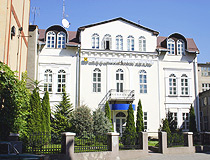
Architecture of Uzhhorod
Author: Balassa Botond
Uzhhorod - Features
The first written mention of the town of Gunkvar (Ungvar) as the largest trading center in the northeastern part of the Kingdom of Hungary was made by the Arab traveler Al-Idrisi in 1154. The town from the time of its first mention had only one name until the end of the First World War: Ungvar (variations Gunkvar, Gungvar, Ongvar).
The word itself consists of two parts: “Ung” and “var”. As for the second of them, historians are unanimous here, since the word “var” in the Hungarian language means “fortification, fortress, castle.” The etymology of the word “Ung” causes great debate.
In the middle of the 19th century, the name Uzhhorod appeared. It arose under the influence of the rise of national movements of the Russian population of the region, especially during the Hungarian revolution of 1848-1849. Instead of the word “Ung”, the word “Uzh” was used, and the Hungarian “var” (“castle, fortress”) was translated into the Slavic word “gorod” (“city”).
However, the new name of the town - “Uzhhorod” - did not take root at that time. It returned only after the First World War, when Transcarpathia ceded to Czechoslovakia and the new government decided to Slavicize the names of towns and villages of the region. Since then, with the exception of a short period (1938-1944), when Transcarpathia was part of Hungary, the name Uzhhorod has been officially used.
The coat of arms of Uzhhorod was approved by the decision of the Uzhhorod City Council dated June 14, 1990. It depicts three golden vines growing from the ground, crossing each other, with three leaves and two bunches of grapes on them. In general, it repeats the historical coat of arms of Uzhhorod known from the middle of the 17th century.
Uzhhorod is located at an altitude of about 120 meters above sea level, 800 km southwest of Kyiv, right on the border with Slovakia. The length of the city from north to south is 5 km, from east to west - 8 km. The Uzh River divides the city into two parts, a significant part of the city area is the Right Bank part (Old City), which is somewhat larger than the left bank. The City Day of Uzhhorod is celebrated on the last Saturday of September.
The climate is temperate continental, with warm summers and mild winters. Uzhhorod is protected by the Carpathians from cold northern winds. And since it is located in the very south-west of the country, the climate of this city is one of the most favorable throughout Ukraine. The average temperature in January is minus 1.7 degrees Celsius, in July - plus 20.9 degrees Celsius.
Uzhhorod is the largest transport hub of Zakarpattia Oblast, through which a number of European highways pass - E50, E58, E573, as well as international highways M06, M08. The city has a checkpoint on the border with Slovakia: Uzhhorod - Vysne Nemecke. Uzhhorod is the only regional center of Ukraine without electric transport (trolleybuses).
Uzhhorod is a city with significant architectural heritage. Architectural monuments of state and local significance (ensembles and separate unique houses) have been preserved here. Throughout its more than a thousand-year history, Uzhhorod changed hands more than once. The almost six hundred-year presence of the Hungarians left a noticeable mark on its architectural appearance. In the 1930s, Czech architects created an architectural ensemble of the center of Uzhhorod in forms close to constructivism.
From 2010 to 2016, more than 30 mini-sculptures were installed in Uzhhorod, monuments the size of a human palm by sculptor Mihajlo Kolodko. Most of them are concentrated in the central part of the city, along the embankment, on both sides of the Uzh River. Each sculpture relates to Uzhhorod or Transcarpathia and is a mini-portrait of interesting, historical figures, mythical characters. A special route has been developed for tourists to search all mini-sculptures, it takes about 3.5 hours using a guidebook.
In spring, cherry blossoms dress Uzhhorod in fragrant pale pink clouds. Tourists from all over the world come to see this beautiful spectacle, because this can’t be seen anywhere else in Europe. Cherry blossoms in Uzhhorod usually bloom in the second or third decade of April (it all depends on the weather) and bloom for about two weeks. Most of them are in the old part of the city - on Pushkina Square, on Druhetiv, Dovzhenka, Rakotsi Streets.
Main Attractions of Uzhhorod
Uzhhorod Castle - the historical center of Uzhhorod and its main tourist attraction, one of the best preserved medieval fortifications on the territory of Ukraine. The castle was built in the Middle Ages by the Hungarian noble family of Drugeths, then rebuilt several times. It is located in the heart of Uzhhorod on a hill of volcanic origin. From the castle wall you can enjoy a great view of the city. In the dungeon of the Uzhhorod Castle, you can taste Transcarpathian wines.
Today, on the territory of this architectural monument of the 13th-18th centuries, the Transcarpathian Regional Museum of Local Lore is located. It has the largest collection of monuments on history, ethnography and culture of Ukrainian Transcarpathia.
The most interesting expositions include Ukraine’s largest collection of bronze treasures and Celtic antiquities, a numismatic collection, rare manuscripts and books, a collection of embroidered shirts and folk clothes of Transcarpathia, materials on the history of religion and culture of the region, folk musical instruments of Transcarpathia, cold steel arms and firearms of the 16th-20th centuries. Kapitul’na Street, 33.
Museum of Folk Architecture and Rural Life - an open-air museum located in the very center of Uzhhorod next to the Uzhhorod Castle. On the territory of this museum you can see the architectural monuments of old Transcarpathian villages and examples of the oldest and most common types of folk applied art. This is one of the first open-air museums in Ukraine, which was opened on June 27, 1970.
The museum exhibits houses of the Transcarpathians of the lowland areas (Rusyns-Dolinyans, Romanians and Hungarians), as well as mountaineers (Boikos and Hutsuls). In total, there are 13 houses, a church, a bell tower, a school, a smithy, a mill, and a tavern. The Church of the Holy Archangel Michael (1777) is one of the best wooden churches in Ukraine. Kapitul’na Street, 33.
Holy Cross Cathedral (1640-1646) - the main Greek Catholic church of Uzhhorod and the residence of the bishops of the Mukachevo Greek Catholic diocese, an architectural monument of national importance, which combines the features of two styles - neo-baroque and classicism. This is one of the most recognizable architectural symbols of Uzhhorod. Kapitul’na Street, 9.
Uzhhorod Linden Alley - the longest linden alley in Europe, a unique monument of garden and park architecture. The length of the alley is 2.2 km. It starts from the Linguistic Gymnasium (Nezalezhnosti Embankment, 4) and stretches along the banks of the Uzh River along two embankments - Nezalezhnosti and Studentska.
In 1928, Czechoslovak biologists planted lindens here for the first time: a total of 300 trees of different species blooming for about two weeks one after another from May to mid-summer. In spring, sakura trees also bloom on the surrounding streets. At the same time, magnolias, Japanese quince, Florida and Chinese apple trees, and other exotic trees and bushes bloom in Uzhhorod.
Stone Pedestrian Bridge - a favorite place for residents of Uzhhorod and guests of the city, from here the Uzhhorod Linden Alley begins. This place is especially liked by couples in love who come here on dates. This is also a great place to watch sunsets. Thanks to the illumination, it is especially picturesque in the evening and at night. You can take great photos here. Nezalezhnosti Embankment, 1.
Korzo Street - a cobbled pedestrian street located in the center of Uzhhorod. Its name is translated from Italian as “street where people walk”. This is the oldest street in Uzhhorod, a lot of old two-three-story buildings decorated with stucco have been preserved here. The architectural style of Korzo Street was formed in the late 19th - early 20th centuries, at a time when the city was part of Austria-Hungary and Czechoslovakia. It is quite crowded, with a number of shops, bars and restaurants. Unlike Linden Alley, there is no greenery here.
Transcarpathian Regional Art Museum of Joseph Bokshay. The department of Russian art is represented by artists of the late 19th - early 20th century: O. Kiprensky, V. Tropinin, I. Shishkin, I. Aivazovsky. Among Ukrainian art, the works of T. Shevchenko, A. Murashko, S. Vasilkovsky, K. Grutovsky should be noted.
A significant part of the exposition is dedicated to the works of Transcarpathian masters: J. Bokshay, F. Manail, E. Kontratovych, G. Gluck, and others. Foreign art is represented by works of artists of Central and Western Europe: Lambert Lombard, Claude-Joseph Vernet, Francesco Albani, Palma Vecchio. Also there is a hall of icon painting of the 17th-18th centuries. Zhupanats’ka Square, 3.
Uzhhorod Synagogue (1904) - one of the most picturesque buildings in Uzhhorod built on the bank of the Uzh River in neo-Moorish style interspersed with Byzantine and Arab-Moroccan motifs. After reconstruction, in the late 1940s, a philharmonic society was opened in the synagogue. Its organ with three keyboards and 2,250 pipes is one of the best musical instruments of this design in Ukraine. This building is known for its excellent acoustics, which has no analogues in Transcarpathia. Teatralna Square.
Horyanska Rotunda (Church of St. Anne) - one of the oldest churches in the Zakarpattia region built between the 10th and the 14th centuries. An architectural monument of national importance, it is located in Horyany, a suburb of Uzhhorod. Its architectural design has no analogues in Ukraine; rotundas similar in style can only be found in Hungary. Inside you can see wall paintings in the style of the Italian school of Giotto dating back to the 14th century. Muzeinyi Lane, 2.
Botanical Garden of Uzhhorod National University - a monument of landscape architecture of national importance with several thousand species of plants placed geographically, with areas of American, Caucasian, Central Asian, Chinese, Far Eastern plants. Near the territory of the botanical garden you can find Uzhhorod children’s railway. Ol’brakhta Street, 6.









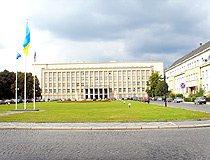



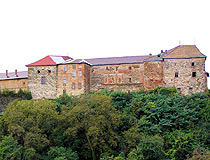
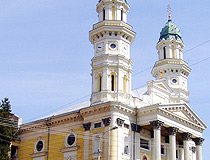
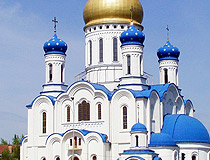
The comments of our visitors